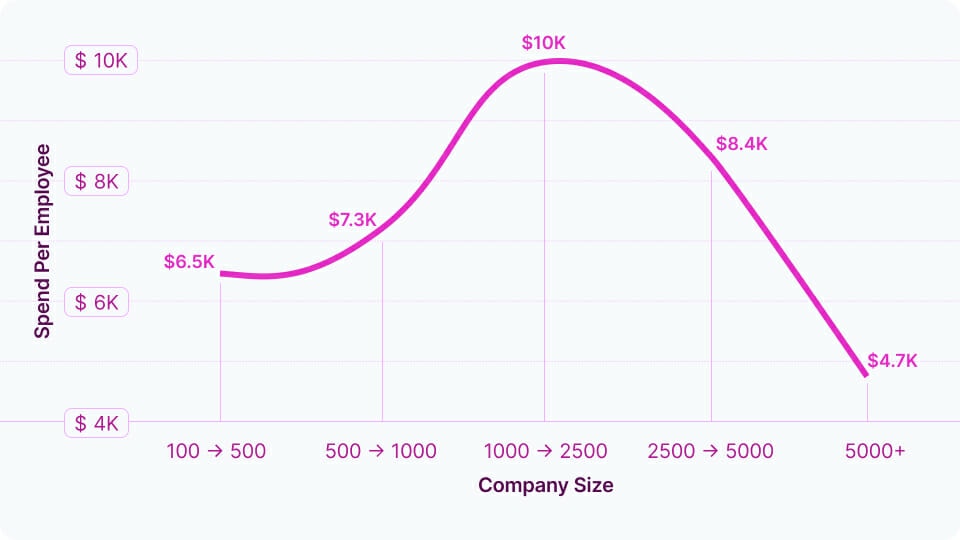SaaS procurement at any organization is a complex process, comprising many moving parts — from the unique needs of each branch of the business to the budgets that tighten with each passing year. And that’s not to mention rising SaaS prices, which in 2022, continued to increase at a rate four times higher than market inflation.
So, when procuring new contracts and renewing business-critical subscriptions, how can you ensure your spend is kept to a minimum?
In short, by gaining SaaS purchasing power.
Let’s take a closer look at what this could mean for your organization and the techniques you could use to achieve it.
Why is purchasing power important in SaaS procurement?
SaaS purchasing power ultimately refers to an organization’s ability to secure more favorable terms and pricing when buying or renewing software subscriptions.
And it’s becoming all the more important given how rising SaaS costs are fast becoming unsustainable – according to our data, the average SaaS portfolio grows by 18% year on year, while prices increase by an additional 12% per annum.
Taking steps to maximize your purchasing power is therefore crucial if you’re looking to optimize your SaaS spending and ultimately drive down costs.
After all, regardless of whether you rely on fewer or drastically more than the 130 different applications deployed by the average organization, these costs can quickly accumulate, threatening not just your IT budget, but your bottom line as a company.
How much do companies spend on SaaS per employee?
The total amount that companies are spending on SaaS per individual employee is rising. While this will vary depending on the industry, company size, and specific software needs, our SaaS purchasing insights for April revealed that mid-sized companies spend twice as much on SaaS per employee than scaled enterprises.

But why is the cost per head so much higher for smaller teams?
Put simply, it’s because of purchasing power.
The amount being spent on each employee varies substantially with a company’s headcount, most likely due to volume-based discounts that larger teams can secure based on their higher gross expenditure.
SaaS providers typically follow the philosophy that customers who use more of the product should get a discount according to their higher usage.
As you’d expect, SaaS vendors are keen to retain the custom of their most profitable accounts — meaning that organizations with a seat count of over 5,000 pay a markedly lower amount of $4.7k per head than an organization with 1,000-2,500 employees, paying $10k per head. This ensures that vendors hold on to their largest clients during periods of scaling.
The organizations that possess higher purchasing power stand to benefit from a range of factors, including:
Cost optimization
The cost of SaaS per employee varies significantly depending on the number of licenses, subscription terms, and type of pricing structure. Gaining purchasing power allows organizations to reduce their per-employee software expenditure, freeing up cash flow to be re-invested elsewhere in the business.
Flexibility
Higher SaaS purchasing power provides flexibility in adapting to changing business needs. Procurement managers are free to negotiate more flexible contract terms beyond just pricing, making it easier to scale up or down as required.
Risk mitigation
Strong purchasing power enables organizations to negotiate favorable service-level agreements (SLAs) and data security provisions, reducing the risks associated with downtime, data breaches, or other service disruptions.
Strategic decision making
Procurement managers with purchasing power can make strategic decisions based on value rather than cost alone. Without being constrained by budget limitations, they can prioritize SaaS solutions that align with the company’s long-term goals.
For example, if you know you’ll need to scale up your DevOps resource short-term to prepare for a new product development cycle, higher purchasing power could enable you to negotiate higher usage within a limited period before returning to your usual resource allocation.
However, without a solid negotiation strategy, it’s challenging for small to medium-sized businesses to access these benefits. This is because more modest teams lack the headcount to leverage during negotiations.
So, what’s the solution for these companies?
How to gain purchasing power without the enterprise-level headcount
While the strongest purchasing power is often associated with large, scaled enterprises that can invest significantly in IT procurement, small to medium-sized organizations can still enhance their purchasing power.
These are some of the top strategies we recommend:
Understand utilization rates
An early step you can take to gain purchasing power is to perform an audit on your existing SaaS tools. By evaluating usage rates across the company and understanding the terms and limitations of your current subscriptions, you’ll be able to approach negotiations equipped with a clear understanding of what you have, what you need, and what you can afford to consolidate.
This way, you’ll be better equipped to align any new procurement to your business ambitions, and less likely to be upsold a contract that you don’t require.
At this stage, it may be useful to deploy SaaS discovery techniques if you haven’t already — and compile a comprehensive system of record of all your existing contracts and important terms.
Request the removal of auto-renewal clauses
Although it might be your top priority, lowering the recurring cost that you pay for software subscriptions isn’t the only way to make savings. There are a variety of different contract terms that can be negotiated, such as auto-renewal clauses.
89% of software vendors include these clauses in their contracts. But if you only require a tool for a short amount of time, or you need to downsize your plan, auto-renewal can become costly. Many businesses are often caught out by a passed renewal date due to poor software management, and in the process, void their opportunity to renegotiate the contract.
By requesting the removal of an auto-renewal clause or asking providers to give you early notification of a repeated billing cycle, you give yourself time to audit the tool’s usage within the company. From this, you can make a decision on whether to retain, adjust or terminate the subscription. Plus, you may be able to leverage your loyalty to the provider and attain a discount at renegotiation.
Discuss price uplift protection
Our data shows that SaaS vendors increase their pricing by an average of 9% each year, with many inserting clauses into their contracts to allow them to do so with little or no notification.
To counter this, well-prepared SaaS buyers may negotiate price uplift protection to safeguard against unexpected increases. For example, you might request a cap on how much a contract cost can go up in price each year, or ask vendors to provide early notification of any adjustments to give you a chance to renegotiate.
Before signing a contract, discuss any price uplift clauses and your options to protect yourself against price hikes when it comes time to renew.
Allow ample time for negotiations
A rushed negotiations process is another hurdle that drives up business SaaS costs and leads to less favorable terms. To secure more purchasing power, allocate sufficient time for discussions with SaaS vendors so that you can explore all your available options.
This goes for both new purchases and renewals. By starting negotiations with your vendor early, you ensure that they won’t pressure you into a rash decision or exploit any need you might have for a fast turnaround time. When vendors realize that buyers need a deal to be closed quickly, they may be less flexible in the discount or terms they’re willing to provide.
By planning ahead, you can remove any pressure, take time to understand your needs, and engage in more fruitful discussions. And if you’re certain that the tool will be a long-term fixture of your SaaS stack, you might also use this time to consider a longer commitment period.
The offer of an annual or even a multi-year subscription can often be leveraged for a discount from vendors. We’ve seen that providers typically offer a discount of an extra 5% for each additional year that a buyer commits to.
Leverage pricing benchmarks
One of the best forms of leverage is intel into what other companies similar to your own pay for their software subscriptions. These pricing benchmarks can provide insight into the terms and rates offered to your peers so that you know whether you’re getting a good deal or need to negotiate for a better one.
Regardless of your company headcount, this is one of the most effective ways to gain purchasing power in the negotiation process — and pay less for your software procurement.
But how can you access these invaluable pricing benchmarks?
For this, you’ll need to speak to Vertice.
Gain unrivaled purchasing power by partnering with Vertice
Vertice has access to the transactional data for more than 16,000 SaaS vendors, which can be leveraged for maximum purchasing power. We can provide your organization with the data you need, or even go one step further and negotiate with vendors on your behalf. Our expert team of SaaS buyers are experienced in either side of the software procurement process, and know the tricks of the trade to secure best-in-class pricing and terms in every deal.
But we don’t just help you buy the software you need — we can also assist with its management. Effective SaaS management equips you with the insights you need to make more informed procurement decisions.
Our automated SaaS management platform provides you with visibility into each contract’s usage, billing and renewal details, supporting you to reduce the amount of time you spend on procurement and secure higher cost savings.
Learn more about the benefits of choosing Vertice as your procurement partner, or see for yourself how much you could be saving on your annual SaaS spend today.

